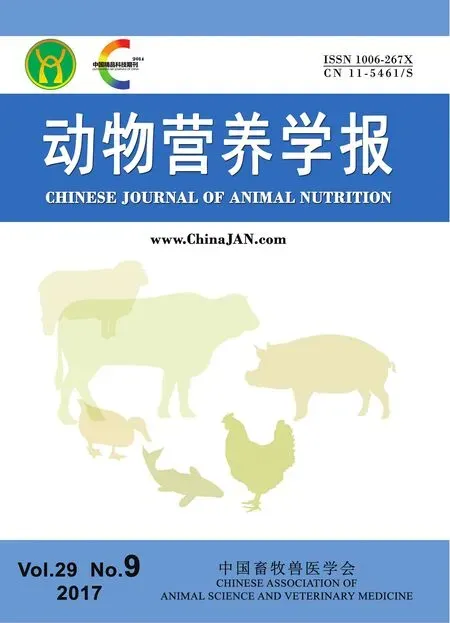精氨酸在体内和体外试验中对鲤鱼免疫力的影响
2017-09-16程镇燕孙金辉乔秀亭
程镇燕 曲 木 孙 颖 于 宏 孙金辉 乔秀亭*
(1.天津农学院水产学院,天津市水产生态及养殖重点实验室,天津300384;2.天津现代晨辉科技集团有限公司,天津市水族动物功能性饲料企业重点实验室,天津301800;3.天津海友佳音生物科技股份有限公司,天津300350)
精氨酸在体内和体外试验中对鲤鱼免疫力的影响
程镇燕1曲 木2孙 颖1于 宏3孙金辉1乔秀亭1*
(1.天津农学院水产学院,天津市水产生态及养殖重点实验室,天津300384;2.天津现代晨辉科技集团有限公司,天津市水族动物功能性饲料企业重点实验室,天津301800;3.天津海友佳音生物科技股份有限公司,天津300350)
本试验采用体外和体内2种方法来研究精氨酸(Arg)对鲤鱼免疫力的影响。体外试验中,在培养基中分别添加0、0.5、1.0、1.5和2.0 mmol/L的Arg,将肾脏白细胞培养不同的时间段后测定增殖指数、呼吸爆发活力、吞噬活力和杀菌率。体内试验中,将平均体重37 g的鲤鱼随机分为5组,每组3个重复,每个重复10条,分别体内注射0、25、50、100和200 mg/kg鱼体重的Arg,商业饲料投喂2周,进行肾脏白细胞增殖指数、呼吸爆发活力和吞噬活力的测定,以及血清和肝胰脏一氧化氮(NO)含量、一氧化氮合成酶(NOS)活性及血清白蛋白(ALB)含量的测定。体外试验结果表明:添加Arg能够提高肾脏白细胞的增殖指数、呼吸爆发活力、吞噬活力和杀菌率。培养12和24 h后,1.0、1.5和2.0 mmol/L Arg组肾脏白细胞增殖指数显著高于0 mmol/L Arg组(P<0.05);培养6、12和24 h后,1.0 mmol/L Arg组肾脏白细胞呼吸爆发活力显著高于0 mmol/L Arg组(P<0.05);培养12和24 h后,1.0、1.5和2.0 mmol/L Arg组肾脏白细胞吞噬活力显著高于0 mmol/L Arg组(P<0.05);培养18 h后,1.0、1.5和2.0 mmol/L Arg组肾脏白细胞杀菌率显著高于0 mmol/L Arg组(P<0.05)。体内试验结果表明:50、100和200 mg/kg Arg组肾脏白细胞呼吸爆发活力、吞噬活力和增殖指数显著高于0 mg/kg Arg组(P<0.05);100和200 mg/kg Arg组血清ALB和NO含量显著高于0 mg/kg Arg组(P<0.05),50、100和200 mg/kg Arg组血清NOS活性显著高于0 mg/kg Arg组(P<0.05);50、100和200 mg/kg Arg组肝胰脏NO含量显著高于0 mg/kg Arg组(P<0.05),25和50 mg/kg Arg组肝胰脏NOS活性显著高于0 mg/kg Arg组(P<0.05)。由此可见,Arg提高了鲤鱼肾脏白细胞的免疫力,体外试验表明Arg的适宜浓度为1.0 mmol/L。正常摄食情况下,Arg在鲤鱼体内注射适宜浓度为50~100 mg/kg。
精氨酸;鲤鱼;免疫力;细胞培养
蛋白质是生命的物质基础,机体中的每一个细胞和所有重要组成部分都有蛋白质参与。蛋白质摄入量不足会影响抗体的形成;蛋白质的缺乏也会导致维生素或微量元素的缺乏,从而降低机体的营养水平和免疫能力,影响养殖动物的健康。补充适量的相应氨基酸,可以起到增强蛋白质的合成和提高免疫力的作用。其中有一类氨基酸叫做功能性氨基酸,它是指除了合成蛋白质外还具有其他特殊功能的氨基酸,不仅对动物的正常生长和维持是必需的,而且对很多生物活性物质的合成也是必需的[1]。精氨酸(Arg)是功能性氨基酸的一种。目前Arg在哺乳动物方面报道颇多[2-5],研究表明,Arg参与体内蛋白质的沉积,通过多种酶参与机体代谢,并通过其代谢产物一氧化氮(NO)和多胺等在动物体内发挥多重营养生理效应[4];此外,作为一种重要的生物活性物质,多胺能参与蛋白质合成、细胞增殖分化,还能调节基因的表达[5-6]。

鲤鱼俗称鲤拐子,原产亚洲,是温带性淡水鱼,杂食性。鲤鱼生长很快,肉质鲜美,是我国养殖鱼的主要品种之一。Arg作为一种功能性氨基酸在水产动物上的研究目前还不深入[11],本试验以鲤鱼为研究对象,通过在体外培养基中添加Arg的方法,筛选敏感的免疫指标,确定Arg适宜添加浓度,再通过体内注射Arg来进一步验证其对鲤鱼生理生化指标及免疫力的影响,以期为绿色环保健康的水产养殖提供参考。
1 材料与方法
1.1试验设计
试验鱼来自天津市换新水产良种场同一批繁殖的鲤鱼鱼种,鱼体消毒后放入水箱中暂养1周。Arg购自台湾MDbio公司,纯度为99.4%。
体外试验:取体格健壮、大小相似(平均体重34 g)的试验鱼27尾,麻醉后,静脉取血,然后解剖获得头肾和中肾,放在0.85%生理盐水中,洗去附着的血细胞。向RPMI-1640培养基中分别加入0、0.5、1.0、1.5和2.0 mmol/L的Arg,制成5种不同浓度梯度的培养基,用于白细胞的培养,用2个独立的复合样品(每个样本3个重复)进行免疫学指标的测定。
体内试验:将150尾重量和大小相近的鲤鱼,随机分为5组,每组3个重复,每个重复10尾,以重复为单位放养于水箱(110 L)中,投喂商业饲料,每天2次。1周后,用Arg药剂配制不同浓度的Arg溶液,5组试验鱼Arg注射量分别为0、25、50、100和200 mg/kg鱼体重,腹腔注射,注射剂量为0.5 mL,注射完后继续每天投喂商业饲料,投喂2周后解剖采样。
1.2样品制备与测定
体外试验:按照程镇燕等[12]方法进行白细胞的分离和原代培养,调整细胞悬浮液密度至每毫升2×107个细胞,要求用0.1%台盼蓝染色测定活力均大于95%。将肾脏白细胞培养12和48 h后测定增殖指数,培养2、6、12、24 h后测定呼吸爆发活力,培养12 h后测定吞噬活力,培养18 h后测定杀菌率。具体测定方法参考程镇燕等[12]的方法。
体内试验:用经过7%肝素钠溶液润湿的注射器从尾部静脉抽血,将每条鱼的血液单独放1个离心管里,血液样本以4 000 r/min离心10 min,收集血清,血清保存在-80 ℃冰箱中待测。之后解剖鱼体,取肝胰脏,放入匀浆器中进行研磨,用0.85%生理盐水进行稀释,2 500 r/min离心10 min,取上清液进行白蛋白(ALB)、NO含量及一氧化氮合酶(NOS)活性的测定(具体测定方法参照南京建成生物工程研究所试剂盒说明书)。取头肾、中肾放于生理盐水中清洗表面血污,然后放在培养液中进行培养,按照Buentello等[8]的方法进行增殖指数、呼吸爆发活力和吞噬活力的测定。
1.3数据处理
所得数据用SPSS 16.0统计软件做单因素方差分析(one-way ANOVA),若差异达到显著水平(P<0.05),则采用Duncan氏法进行组间多重比较。
2 结 果
2.1培养基中添加Arg对鲤鱼肾脏白细胞增殖指数的影响
如图1所示,培养基中添加Arg后,鲤鱼肾脏白细胞的增殖指数明显升高。培养12 h后,1.0、1.5和2.0 mmol/L Arg组肾脏白细胞的增殖指数显著高于0和0.5 mmol/L Arg组(P<0.05),0和0.5 mmol/L Arg组之间无显著差异(P>0.05),1.0、1.5和2.0 mmol/L Arg组之间无显著差异(P>0.05)。培养48 h后,随着培养基中Arg浓度的增加,肾脏白细胞的增殖指数逐渐提高,2.0 mmol/L Arg组肾脏白细胞的增殖指数最高,显著高于0、0.5、1.0 mmol/L Arg组(P<0.05),但与1.5 mmol/L Arg组差异不显著(P>0.05)。除添加1.0 mmol/L Arg组培养48 h后的肾脏白细胞的增殖指数较培养12 h有所降低外,其他均有所增高。
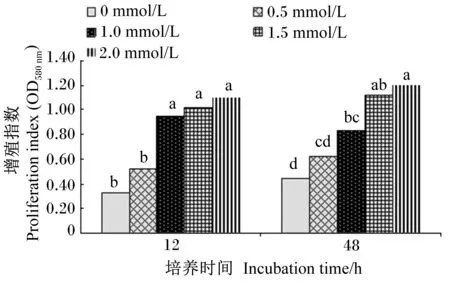
数据柱标相同小写字母表示差异不显著(P>0.05),不同小写字母表示差异显著(P<0.05)。下图同。
Value columns with the same small letter mean no significant difference (P>0.05), while with different small letters mean significant difference (P<0.05). The same as below.
图1培养基中添加Arg对鲤鱼肾脏白细胞增殖指数的影响
Fig.1 Effects of culture media supplemented with Arg on proliferation index of leukocytes in carp kidney
2.2培养基中添加Arg对鲤鱼肾脏白细胞呼吸爆发活力的影响
如图2所示,培养基中添加Arg后,鲤鱼肾脏白细胞的呼吸爆发活力明显升高。培养2 h后,0.5、1.0、1.5、2.0 mmol/L Arg组肾脏白细胞呼吸的爆发活力较0 mmol/L Arg组均有所增加,但是各组之间差异不显著(P>0.05)。培养6、12、24 h后,1.0、1.5、2.0 mmol/L Arg组之间肾脏白细胞的呼吸爆发活力差异不显著(P>0.05),但是较0和0.5 mmol/L Arg组却有明显提高,其中1.0 mmol/L Arg组显著高于0 mmol/L Arg组(P<0.05);随着培养时间的延长,各组肾脏白细胞的呼吸爆发活力均呈现先上升后下降的趋势,且最高值发生在培养12 h后的1 mmol/L Arg组中。

图2 培养基中添加Arg对鲤鱼肾脏白细胞呼吸爆发活力的影响
2.3培养基中添加Arg对鲤鱼肾脏白细胞吞噬活力的影响
如图3所示,培养基中添加Arg后,鲤鱼肾脏白细胞的吞噬活力均有所提高。培养12 h后,各组肾脏白细胞的吞噬活力随着培养基中Arg浓度的增加呈上升趋势,2.0 mmol/L Arg组肾脏白细胞的吞噬活力最高,显著高于0和0.5 mmol/L Arg组(P<0.05),与1.0、1.5 mmol/L Arg组差异不显著(P>0.05)。培养24 h后,各组肾脏白细胞的吞噬活力也是随着培养基中Arg浓度的增加呈上升的趋势,1.5、2.0 mmol/L Arg组肾脏白细胞的吞噬活力显著高于其他各组(P<0.05)。
2.4培养基中添加Arg对鲤鱼肾脏白细胞杀菌率的影响
如图4所示,培养基中添加Arg培养18 h后,鲤鱼肾脏白细胞的杀菌率(迟钝爱德华氏菌)均有明显提升。1.0、1.5和2.0 mmol/L Arg组之间肾脏白细胞的杀菌率没有显著差异(P>0.05),但是1.0、1.5 mmol/L Arg组肾脏白细胞的杀菌率显著高于0和0.5 mmol/L Arg组(P<0.05),其中在1 mmol/L Arg组肾脏白细胞的杀菌率达到顶峰。
2.5注射Arg对鲤鱼肾脏白细胞呼吸爆发活力、吞噬活力和增殖指数的影响
如表1所示,鲤鱼注射Arg后,肾脏白细胞呼吸爆发活力、吞噬活力和增殖指数均有所提高。随着Arg注射浓度的增加,肾脏白细胞呼吸爆发活力呈现先上升后趋于稳定的趋势,100和200 mg/kg Arg组达到最高值,显著高于0和25 mg/kg Arg组(P<0.05),与50 mg/kg Arg组差异不显著(P>0.05)。随着Arg注射浓度的增加,肾脏白细胞吞噬活力呈逐渐提高的趋势(P<0.05),200 mg/kg组达到最高值,与100 mg/kg Arg组差异不显著(P>0.05),但显著高于其他各组(P<0.05)。肾脏白细胞增殖指数的变化趋势与吞噬活力变化趋势一致,除25 mg/kg Arg组与0 mg/kg Arg组差异不显著(P>0.05)外,其余各组均显著高于0 mg/kg Arg组(P<0.05),200 mg/kg组达到最高值。
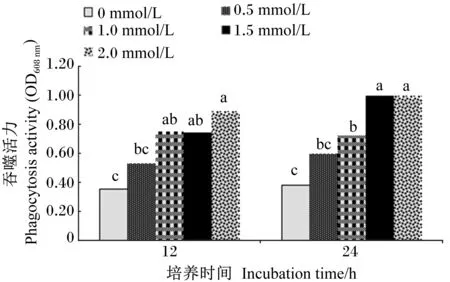
图3 培养基中添加Arg对鲤鱼肾脏

图4 培养基中添加Arg对鲤鱼肾脏白细胞杀菌率的影响
2.6注射Arg对鲤鱼肝胰脏、血清中ALB、NO含量及NOS活性的影响
如表2所示,鲤鱼注射Arg后,血清ALB、NO含量及血清和肝胰脏NOS活性有不同程度提高。随着Arg注射浓度的增加,血清ALB的含量呈现先上升后下降的趋势,100 mg/kg Arg组血清ALB含量最高,显著高于0、25、50 mg/kg Arg组(P<0.05),但0、25、50 mg/kg Arg组之间差异不显著(P>0.05)。
50 mg/kg Arg组肝胰脏中NO的含量最高,显著高于其他各组(P<0.05);100、200 mg/kg Arg组之间差异不显著(P>0.05),但显著高于0和25 mg/kg Arg组(P<0.05)。血清NO的含量则随着Arg注射浓度的增加呈上升趋势,200 mg/kg Arg组血清NO含量最高,显著高于0、25和50 mg/kg Arg组(P<0.05),与100 mg/kg Arg组差异不显著(P>0.05)。
血清和肝胰脏中NOS活性随着Arg注射浓度的增加而呈现先上升后下降的趋势。25 mg/kg Arg组肝胰脏中NOS活性最高,显著高于0和200 mg/kg Arg组(P<0.05),之后随着Arg注射浓度的增加呈下降趋势。50 mg/kg Arg组血清NOS活性最高,显著高于其他各组(P<0.05),之后随着Arg注射浓度的提高呈下降趋势。
3 讨 论
3.1Arg对鲤鱼肾脏白细胞增殖能力的影响

3.2Arg对鲤鱼肾脏白细胞呼吸爆发活力的影响

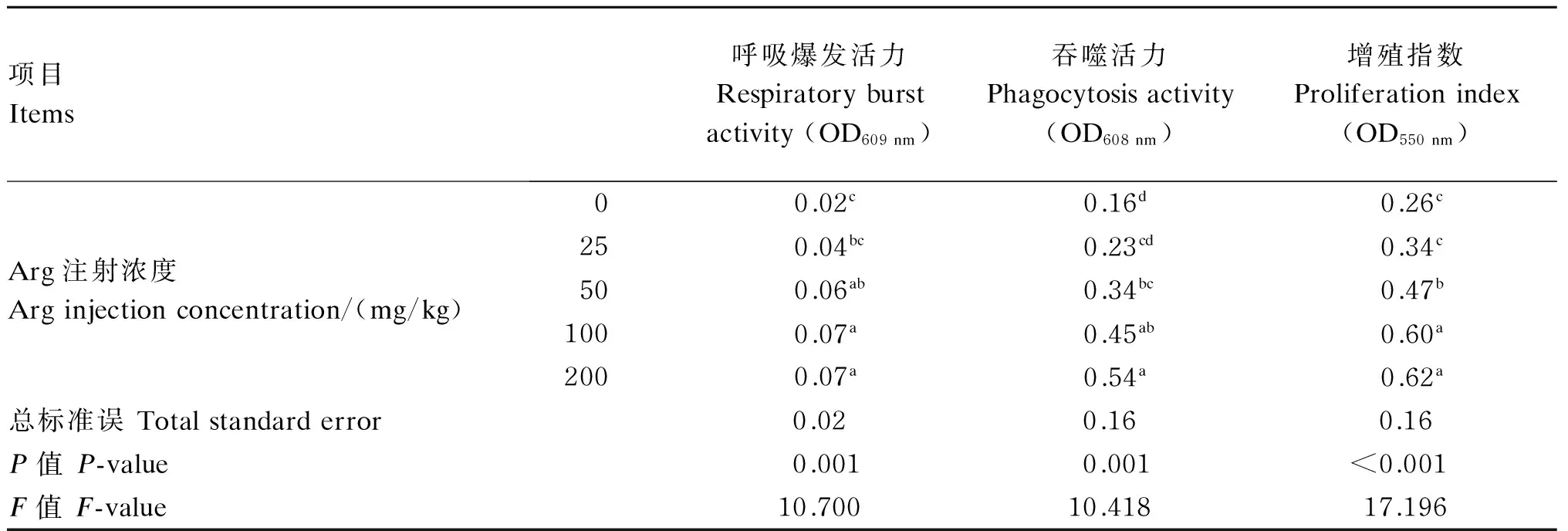
表1 注射Arg对鲤鱼肾脏白细胞呼吸爆发活力、吞噬活力和增殖指数的影响
同列数据肩标不同小写字母表示差异显著(P<0.05),相同或无字母表示差异不显著(P>0.05)。下表同。
In the same column, values with different small letter superscripts mean significant difference (P<0.05), while with the same or no letter superscripts mean no significant difference (P>0.05). The same as below.
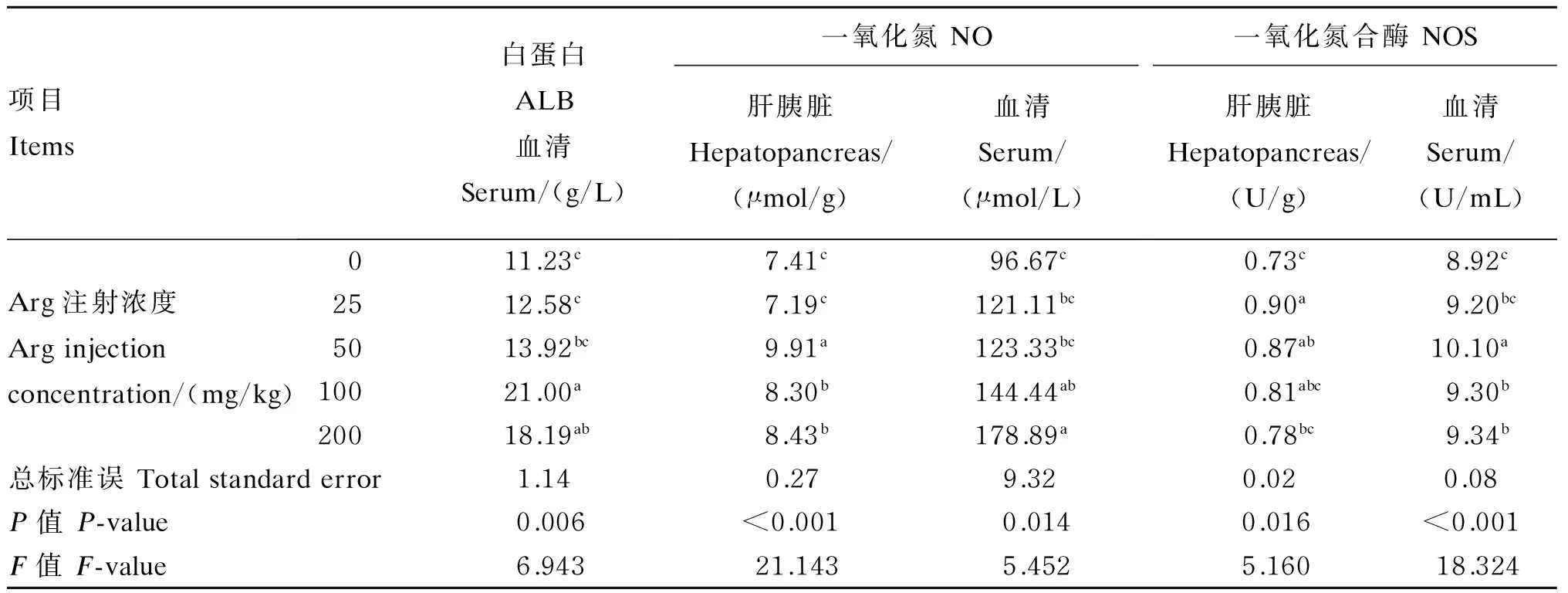
表2 注射Arg对鲤鱼肝胰脏、血清中白蛋白、一氧化氮含量及一氧化氮合酶活性的影响
3.3Arg对鲤鱼肾脏白细胞吞噬能力和杀菌能力的影响

3.4注射Arg对鲤鱼血清和肝胰脏中ALB、NO含量及NOS活性的影响
本试验发现,注射一定浓度的Arg可以有效提高鲤鱼血清ALB的含量,而Arg又是生物体内NO合成的前体物质,随着Arg浓度的增加,鲤鱼血清和肝胰脏中NO含量提高,血清中NO含量在Arg注射浓度为200 mg/kg时达到最高值。在异育银鲫上的研究结果表明,饲料中添加Arg后,异育银鲫血清中的NO含量呈剂量依赖性增加[21]。NOS是NO合成的关键酶,其活性反映组织产生NO的能力。研究表明,饲料中添加Arg可以提高建鲤头肾诱导型一氧化氮合成酶(iNOS)[18]及军曹鱼血清NOS活性[22];此外,异育银鲫肝脏总NOS活性随饲料中Arg水平的增加而增强[21]。本试验发现,体内注射Arg后提高了血清和肝胰脏中NOS的活性,相应的,NOS活性的增强也促进了血清和肝胰脏中NO的产生。由此可以说明,Arg能提高鲤鱼NOS活性,促进NO生成。经相关研究表明,Arg-NO途径被认为是杀死细胞内微生物的有效机制,同时也是巨噬细胞对靶细胞毒性的主要机制[4]。产生的NO可以起到杀死动物体内的寄生虫、细菌、病毒,抑制癌症细胞的增殖,提高免疫力和抗病能力的作用[23-24]。所以,添加一定浓度的Arg有利于促进鲤鱼肝胰脏和血清中的细胞产生NO,从而提高鲤鱼的免疫力和抗病能力。
4 结 论
Arg提高了鲤鱼肾脏白细胞的免疫力,体外试验表明Arg的适宜浓度为1.0 mmol/L。正常摄食情况下,Arg在鲤鱼体内注射适宜浓度为50~100 mg/kg。
[1] 印遇龙,孔祥峰,伍国耀.动物功能性氨基酸营养研究进展[C]//动物营养研究进展——中国畜牧兽医学会动物营养学分会第八届全国代表大学暨第十届学术研讨会论文集.杭州:中国畜牧兽医学会,2008:132-145.
[2] LIU Y L,HUANG J J,HOU Y Q,et al.Dietary arginine supplementation alleviates intestinal mucosal disruption induced byEscherichiacolilipopolysaccharide in weaned pigs[J].British Journal of Nutrition,2008,100(3):552-560.
[3] 谭碧娥,李新国,孔祥峰,等.精氨酸对早期断奶仔猪肠道生长、组织形态及IL-2基因表达水平的影响[J].中国农业科学,2008,41(9):2783-2788.
[4] 刘俊峰,胡慧,孔祥峰,等.母猪精氨酸营养研究进展[J].动物营养学报,2010,22(4):840-844.
[5] 吴信,印遇龙,伍国耀.功能性氨基酸——精氨酸和精氨酸生素在猪生产中的研究与应用进展[J].饲料与畜牧:新饲料,2009(8):8-11.
[6] NIEVES C Jr,LANGKAMP-HENKEN B.Arginine and immunity:a unique perspective[J].Biomedicine & Pharmacotherapy,2002,56(10):471-482.
[7] TSUEI B J,BERNARD A C,BARKSDALE A R,et al.Supplemental enteral arginine is metabolized to ornithine in injured patients[J].Journal of Surgical Research,2005,123(1):17-24.
[8] BUENTELLO J A,REYES-BECERRIL M,ROMERO-GERALDO M J,et al.Effects of dietary arginine on hematological parameters and innate immune function of channel catfish (Ictaluruspunctatus)[J].Journal of Aquatic Animal Health,2007,19:195-203.
[9] CHENG Z Y,BUENTELLO J A,GATLIN D M Ⅲ.Effects of dietary arginine and glutamine on growth performance,immune responses and intestinal structure of red drum,Sciaenopsocellatus[J].Aquaculture,2011,319(1/2):247-252.
[10] CHENG Z Y,GATLIN D M Ⅲ,BUENTELLO J A.Dietary supplementation of arginine and/or glutamine influences growth performance,immune responses and intestinal morphology of hybrid striped bass (Moronechrysops×Moronesaxatilis)[J].Aquaculture,2012,362-363:39-43.
[11] 程镇燕,陈韶阳,乔秀亭.鱼类功能性氨基酸营养免疫研究进展[J].饲料研究,2014,(9):53-57.
[12] 程镇燕,李建,雷五长,等.谷氨酰胺对点带石斑鱼免疫细胞免疫力的影响[J].水产科学,2014,33(10):606-610.
[13] BARBUL A.Arginine:biochemistry,physiology,and therapeutic implications[J].Journal of Parenteral & Enteral Nutrition,1986,10(2):227-238.
[14] POHLENZ C,BUENTELLO J A,MWANGI W,et al.Arginine and glutamine supplementation to culture media improves the performance of various channel catfish immune cells[J].Fish & Shellfish Immunology,2012,32(5):762-768.
[15] SUAREZ BUTLER M F,LANGKAMP-HENKEN B,HERRLINGER-GARCIA K A,et al.Arginine supplementation enhances mitogen-induced splenocyte proliferation but does not affectinvivoindicators of antigen-specific immunity in mice[J].The Journal of Nutrition,2005,135(5):1146-1150.
[16] NEWSHOLME P,BRENNAN L,RUBI B,et al.New insights into amino acid metabolism,β-cell function and diabetes[J].Clinical Science,2005,108(3):185-194.
[17] TAN B,LI X G,KONG X F,et al.DietaryL-arginine supplementation enhances the immune status in early-weaned piglets[J].Amino Acids,2009,37(2):323-331.
[18] CHEN G F,LIU Y,JIANG J,et al.Effect of dietary arginine on the immune response and gene expression in head kidney and spleen following infection ofJiancarp withAeromonashydrophila[J].Fish & Shellfish Immunology,2015,44(1):195-202.
[19] GALINDO-VILLEGAS J,FUKADA H,MASUMOTO T,et al.Effect of dietary immunestimulants on some innate immune responses and disease resistance againstEdwardsiellatardainfection in Japanese flounder (Paralichthysolivaceus)[J].Nippon Suisan Gakkaishi,2006,54(2):153-162.
[20] WEYTS F A A,FLIK G,VERBURG-VAN KEMENADE B M.Cortisol inhibits apoptosis in carp neutrophilic granulocytes[J].Developmental & Comparative Immunology,1998,22(5/6):563-572.
[21] TU Y Q,XIE S Q,HAN D,et al.Dietary arginine requirement for gibel carp (Carassisauratusgibeliovar. CAS Ⅲ) reduces with fish size from 50 g to 150 g associated with modulation of genes involved in TOR signaling pathway[J].Aquaculture,2015,449:37-47.
[22] REN M C,AI Q H,MAI K S.Dietary arginine requirement of juvenile cobia (Rachycentroncanadum)[J].Aquaculture Research,2014,45(2):225-233.
[23] 雷晓青,吴伟宗,方洛云,等.精氨酸营养生理功能研究新进展[J].中国畜牧杂志,2009,45(3):46-49.
[24] 石丹,周小秋,赵叶,等.精氨酸对鱼类免疫功能的影响及其机制[J].动物营养学报,2015,27(10):3026-3032.
*Corresponding author, professor, E-mail: qxt65@sohu.com
(责任编辑 武海龙)
Effects of Arginine on Immunity of Carp (Cyprinus carpio) in Vivo and in Vitro Experiment
CHENG Zhenyan1QU Mu2SUN Ying1YU Hong3SUN Jinhui1QIAO Xiuting1*
(1. Tianjin Key Lab of Aqua-Ecology and Aquaculture, College of Fisheries, Tianjin Agricultural University, Tianjin 300384, China; 2. Tianjin Enterprise Key Lab of the Functional Feed of Aquatic Animals, Tianjin Chenhui Modern Technology Group Co., Ltd., Tianjin 301800, China; 3. Tianjin Ocean Pal Carol Biotech Co., Ltd., Tianjin 300350, China)
Aninvivoand ainvitroexperiment were conducted to evaluate the effects of arginine on immunity of carp. In theinvitroexperiment, arginine with the concentrations of 0, 0.5, 1.0, 1.5 and 2.0 mmol/L were added in the culture medium, after different incubation time of kidney leukocytes, the proliferation index, respiratory burst activity, phagocytosis activity and bactericidal rate were assayed respectively. In theinvivoexperiment, the carp of average body weight 37 g were divided into 5 groups, and each group had three replicates, each replicate had 10 fish. Arginine at 0, 25, 50, 100, 200 mg/kg were injected into fish cavity, and then fed them with commercial diets for 2 weeks. Then, the proliferation index, respiratory burst activity and phagocytic activity of kidney leukocytes were determined. At the same time, the nitric oxide (NO) content and nitric oxide synthase (NOS) activity in serum and hepatopancreas, and serum albumin (ALB) content were determined. Theinvitroexperiment results showed that added arginine could increase the proliferation index, respiratory burst activity, phagocytosis activity and bactericidal rate of kidney leukocytes. After 12 and 24 h incubation, the proliferation index of kidney leukocytes in 1.0, 1.5 and 2.0 mmol/L arginine groups was significantly higher than that in 0 mmol/L arginine group (P<0.05); after 6, 12 and 24 h incubation, the respiratory burst activity of kidney leukocytes in 1.0 mmol/L arginine group was significantly higher than that in 0 mmol/L arginine group (P<0.05); after 12 and 24 h incubation, the phagocytosis activity of kidney leukocytes in 1.0, 1.5 and 2.0 mmol/L arginine groups was significantly higher than that in 0 mmol/L arginine group (P<0.05); after 18 h incubation, the bactericidal rate of kidney leukocytes in 1.0, 1.5 and 2.0 mmol/L arginine groups was significantly higher than that in 0 mmol/L arginine group (P<0.05). Theinvivoexperiment results showed that the proliferation index, respiratory burst activity and phagocytosis activity of kidney leukocytes in 50, 100 and 200 mg/kg arginine groups was significantly higher than that in 0 mg/kg arginine group (P<0.05); the serum ALB and NO contents in 100 and 200 mg/kg arginine groups were significantly higher than those in 0 mg/kg arginine group (P<0.05); the serum NOS activity in 50, 100 and 200 mg/kg arginine groups was significantly higher than that in 0 mg/kg arginine group (P<0.05); the hepatopancreas NO content in 50, 100 and 200 mg/kg arginine groups was significantly higher than that in 0 mg/kg arginine group (P<0.05); the hepatopancreas NOS activity in 25 and 50 mg/kg arginine groups was significantly higher than that in 0 mg/kg arginine group (P<0.05). Generally, the arginine can enhance on the immunity of leukocytes in carp, and the optimum arginine concentration is 1.0 mmol/Linvitroexperiment. In normal feeding condition, the optimum arginine injection concentration for carp is 50 to 100 mg/kginvivo.[ChineseJournalofAnimalNutrition,2017,29(9):3293-3300]
arginine; carp; immunity; cell incubation
10.3969/j.issn.1006-267x.2017.09.033
2017-03-02
国家自然科学基金(31402313);天津市应用基础与前沿技术研究计划(14JCQNJC15100)
程镇燕(1981—),女,山东泰安人,副教授,博士,研究方向为鱼类营养生理与免疫。E-mail: chengzhenyan2005@126.com
*通信作者:乔秀亭,教授,硕士生导师,E-mail: qxt65@sohu.com
S963.73+1
:A
:1006-267X(2017)09-3293-08
